|
This was the backbone of the original Saxon settlement, but not recorded as 'Northe Streate' until the 13th century. On the west side there were once 4 private houses and 6 inns, and in 1642 there were about 50 households here. This street has been party to more of the town's history than any other local thoroughfare: kings, queens, the famous and infamous have all passed through it, as have armies, processions, parades and countless marching bands.
At times of national celebration this was the townspeople's congregation point; every building decorated from top to bottom in Union flags and bunting offering residents the most colourful spectacle. It was also the rendevouz point for local celebrations, one of the biggest events ever held here being the grand opening of the Stort Navigation in 1769, which ultimately saved Bishop’s Stortford’s malting industry.
The event was commemorated in unprecedented style, with both dignitaries and townspeople enjoying a day-long street party that culminated in an enormous feast. Come nightfall the party would have been illuminated by oil lamps, but this was to change in 1834 when Parliament passed the Lighting Act, entitled 'Act to repeal an Act of the 11th of George IV, for the lighting and watching of parishes in England and Wales and to make provisions in lieu thereof'.
As a result of this the vestry appointed, on 11 December 1834, new officials called Lighting Inspectors, who the following year drew up a contract with Directors of the newly established Bishop's Stortford Gas Company for lighting the town with gas 'except in such parts thereof as is called New Town'. Initially 59 lamps were installed, probably in North Street and South Street, but within a few years the number had increased throughout the town to about 240 including, presumably, New Town.
When Princess Alexandra of Denmark visited Bishop’s Stortford in 1863, prior to her marriage to Edward Prince of Wales, townspeople marked the occassion by building seven huge arches of evergreen foliage at various points on her route. One of the arches straddled the road here between the Half Moon Inn and the opposite corner where Carr and Bury’s shop now stands. MORE PICTURES
|
|
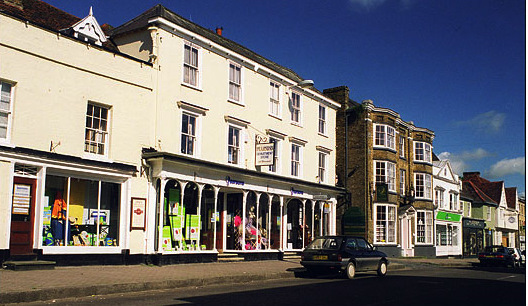
In 1897 North Street was once again a riot of colour for the huge celebration that marked Queen Victoria’s Diamond Jubilee, the party continuing long into the night. Eight years later when King Edward VII passed through the town in his chauffeur driven car, the local Volunteer Fire Brigade, clad in brass helmets and full uniform, stood on either side of this road and formed an arch with their ladders for him to pass under.
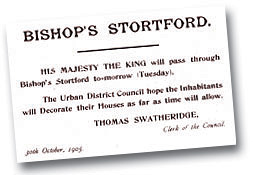 The turn of the 20th century saw regular and varied parades both at Whitsun and Easter, but the street party to end all street parties took place here in 1918 with the ending of the First World War. North Street was the starting point of a huge procession that wound its way around the entire town, and residents partied til’ dawn. Colourful celebrations also took place with the ending of the Second World War in 1945; the coronation of Queen Elizabeth II in 1953 and, most recently, the wedding of Prince Charles and Lady Diana in 1981.
The turn of the 20th century saw regular and varied parades both at Whitsun and Easter, but the street party to end all street parties took place here in 1918 with the ending of the First World War. North Street was the starting point of a huge procession that wound its way around the entire town, and residents partied til’ dawn. Colourful celebrations also took place with the ending of the Second World War in 1945; the coronation of Queen Elizabeth II in 1953 and, most recently, the wedding of Prince Charles and Lady Diana in 1981.
In the early 1900s working horses were still the order of the day but as the mechanisation of farming progressed, local trader and auctioneer G E Sworder regularly displayed large items of farm machinery and associated equipment for sale in North Street (See No 17 – Pearsons). The traffic laws certainly wouldn’t allow such happenings today, nor did they back in 1757 when the Essex and Herts Highways Trust enforced draconian parking regulations – a fine of 40 shillings (£2) or one month's hard labour being the penalty for obstructing the highway with a stationary vehicle. Makes today’s parking fines seem almost generous.
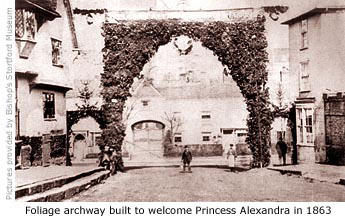 Early illustrations and photographs of North Street show its western side lined with triple-height kerb stones, but over the years that height has been significantly reduced by successive coverings of the road's surface. More noticeable, perhaps, is the fact that all of the buildings on this side of the street date between the 16th and 19th century, while those on the eastern side are mostly 19th century. This is the result of a road widening scheme implemented by the Essex and Herts Highways Trust in 1749, who deemed it necessary that the width of the town’s main highway i.e. North Street and South Street, should be increased to 20ft (6m). As a result, all buildings on the eastern side of the road (except No 10) were demolished. The entire work took four years to complete at a cost of £160. Early illustrations and photographs of North Street show its western side lined with triple-height kerb stones, but over the years that height has been significantly reduced by successive coverings of the road's surface. More noticeable, perhaps, is the fact that all of the buildings on this side of the street date between the 16th and 19th century, while those on the eastern side are mostly 19th century. This is the result of a road widening scheme implemented by the Essex and Herts Highways Trust in 1749, who deemed it necessary that the width of the town’s main highway i.e. North Street and South Street, should be increased to 20ft (6m). As a result, all buildings on the eastern side of the road (except No 10) were demolished. The entire work took four years to complete at a cost of £160.
There are 11 listed properties in North Street, and since the start of the 20th century only two new buildings have been constructed on the eastern side. Every building has a fascinating history but mention here is only of the most notable. MORE PICTURES
|

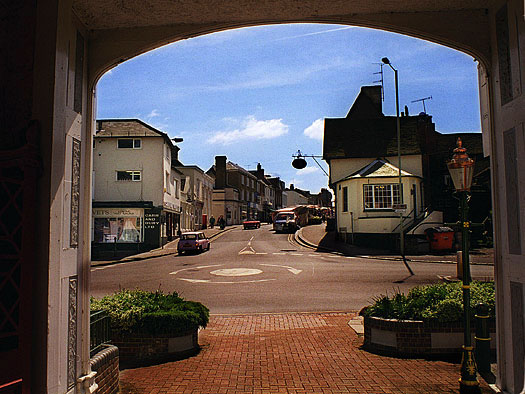

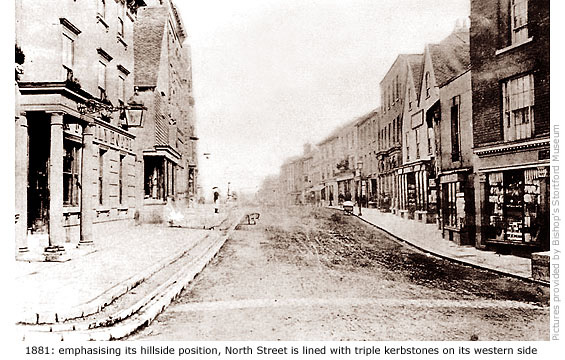


 Early illustrations and photographs of North Street show its western side lined with triple-height kerb stones, but over the years that height has been significantly reduced by successive coverings of the road's surface. More noticeable, perhaps, is the fact that all of the buildings on this side of the street date between the 16th and 19th century, while those on the eastern side are mostly 19th century. This is the result of a road widening scheme implemented by the Essex and Herts Highways Trust in 1749, who deemed it necessary that the width of the town’s main highway i.e. North Street and South Street, should be increased to 20ft (6m). As a result, all buildings on the eastern side of the road (except No 10) were demolished. The entire work took four years to complete at a cost of £160.
Early illustrations and photographs of North Street show its western side lined with triple-height kerb stones, but over the years that height has been significantly reduced by successive coverings of the road's surface. More noticeable, perhaps, is the fact that all of the buildings on this side of the street date between the 16th and 19th century, while those on the eastern side are mostly 19th century. This is the result of a road widening scheme implemented by the Essex and Herts Highways Trust in 1749, who deemed it necessary that the width of the town’s main highway i.e. North Street and South Street, should be increased to 20ft (6m). As a result, all buildings on the eastern side of the road (except No 10) were demolished. The entire work took four years to complete at a cost of £160.